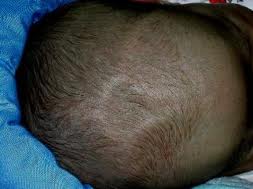What are the Soft Spots on my Newborn Baby’s head?
 You may have heard elders in the family warning about being careful while carrying a newborn baby. When babies are placed into sibling arms they are cautioned not to touch the top portion of the head. This is basically because there are soft spots on the newborn baby’s head.
You may have heard elders in the family warning about being careful while carrying a newborn baby. When babies are placed into sibling arms they are cautioned not to touch the top portion of the head. This is basically because there are soft spots on the newborn baby’s head.
Usually all are curious to know about the soft spot on newborn baby’s head.
The soft spots are called Fontanelles. There are two fontanelles, with varying sizes. The one at the top of the head is called anterior fontanelle. It is larger in size and diamond or kite-shaped. The other one at the back of the head is called posterior fontanelle. It is smaller in size and triangular in shape.
You can see or feel a pulse beneath the fontanelles. There is no bone in that area. Don’t be afraid to touch these spots gently. They’re covered with a tough membrane to protect the delicate contents underneath.
After birth also the doctor or the nurse incharge of the delivery will inspect the baby’s fontanelles. This is a routine check to assess the health of the newborn baby.
At birth, baby’s head bones are relatively soft and connected by tissue. This structure of bones actually helps the baby to pass through the birth canal, the bones will gently slide over the other and smoothly come out into open air. This process is called moulding, when the baby comes out through a small space and be born.
Read this article: Umbilical cord care- Basics for a New Mom
This flexible arrangement allows the skull to compress during labor and to continue to grow during the early years of life. The rear fontanel usually closes within four months, while the front one doesn’t close until the child is at least a year old . For few babies it extends to around 15 to 18 months too.
In India when the baby is massaged with oil prior to a warm bath, oil is poured over the soft spot lavishly. In some parts of South India a soft powder called Raasnadhi podi is rubbed over the soft spot to keep away cold and coughs. This is applied for growing kids too.
The fontanelles will also provide clue to identify baby’s overall health:
- If the soft spot is sunken it is a sign of dehydration. This could be a result of watery motions, baby sickness. Do not hesitate to consult a pediatrician.
- If the soft spot is bulging, this is a sign of a serious illness known as meningitis. Consult the child doctor, do not delay.
- The pulse will also seem low if baby is dehydrated due to insufficient feed. In some instances, the soft spot on the top of your baby’s head may seem to be pulsating. There is no need to worry—this movement is quite normal and simply reflects the visible pulsing of blood that corresponds to your baby’s heartbeat.
As your baby grows your doctor will monitor the baby’s growth and if the head bones are developing naturally. Make sure the baby is placed in a crib when mom is busy as this will avoid falls and unsafe incidents.
When you go out of home cover baby’s head adequately to prevent baby from cold and hot weather.









